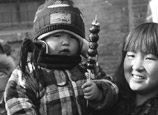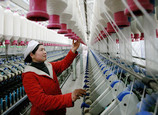
Arousing dispute
Besides Xu, some other reputable economists and research institutes have voiced skepticism about the NBS Gini coefficient figures, arguing that it cannot fully reflect the reality of China's massive income inequality.
According to a report released on December 9, 2012, by China Household Finance Survey and Research Center, affiliated with the Southwestern University of Finance and Economics (SWUFE) located in Chengdu, Sichuan Province, in 2010 the Gini coefficient based on China's household income was 0.61, which is in clear contrast to the figure of 0.481 recently released by the NBS.
At present, Chinese prefer to believe the SWUFE figure. According to NBS figures, in 2012 the per-capita disposable income of urban residents was 24,565 yuan ($3,911.62), which was 3.1 folds of the per-capita net earnings among rural residents of 7,917 yuan ($1,260.67). For the 20 percent of urban residents with the highest incomes, per-capita income came to 51,456 yuan ($8,193.63), while for the 20 percent with the lowest incomes, per-capita income was only 10,354 yuan ($1,648.73).
Why is the SWUFE figure so much higher than that of the NBS? According to Ma, a standard non-governmental survey could be an important and valuable supplement to government information, based on a scientific statistical system and sampling method, a proper number of samples and a prudent attitude to release results.
Ma adds that urban incomes grew faster than the GDP, and that the earnings of rural residents outpaced that of their city counterparts in 2012. Such changes lead to the Gini coefficient drop.
However, public support for the NBS version of Gini coefficient findings does exist. "The NBS says the income gap has narrowed in recent years and that the Gini coefficient is reducing. Why do some claim it's not true? To those who hire housekeepers, is your salary or your housekeepers' salary growing faster? Most low-income groups get higher salaries, but since the global financial crisis, how many large employers are powerful enough to significantly up earnings? The news that China's Gini coefficient is falling seems to make some people unhappy, but can't the country turn better?" said Hu Xijin, editor in chief of Global Times, after reading Xu's Weibo post.
Yu Bin, Director of Macroeconomic Research at the State Council Development Center, thinks that in recent years, income growth among rural residents has been higher than in cities while the income gap is shrinking, creating good conditions for the decline of the Gini coefficient. From this point of view, the NBS figures could be true.
Since 2009, the Central Government has strengthened aid to urban low-income groups and farmers, raising minimum wages, increasing pensions for corporate retirees, upping the individual income tax cutoff point, exempting agricultural taxes, expanding input in rural education and expanding healthcare support. The annual growth of farmer incomes has been higher than that of urban residents for three consecutive years.
However, "middle-class" earnings across cities have shown little improvement. For this group, besides wages, income is derived from stock and real estate market investments. A continuing bear market, coupled with the government's control of real estate, has consumed most middle-class investments. In contrast, the earnings of low-income groups have risen remarkably, narrowing the Gini coefficient.
Liu Huan, a professor with Central University of Finance and Economics in Beijing, says calculating the country's Gini coefficient is a very complicated task. With a large population and a huge number of households, it is hard to get concise statistics on the distribution of income via census. Therefore, most countries adopt a sampling method by which surveyors ensure coverage and representation. This relies on a major amount of manpower and material input, as well as cooperation, making the process difficult. Even international organizations such as the United Nations and World Bank have insufficient channels and capabilities to independently calculate China's Gini coefficient. SWUFE's China Household Finance Survey claims to have analyzed 8,438 samples from 80 counties in 25 provinces. It is never easy to carry out such a survey, which is simply not enough to illustrate the Gini coefficient of a country with a population of 1.35 billion.
Liu thinks the accuracy of calculations by both government and non-state institutions needs to be further demonstrated, perhaps relying more on calculation methods.


















 Most feared Spring Festival questions
Most feared Spring Festival questions


![]()
